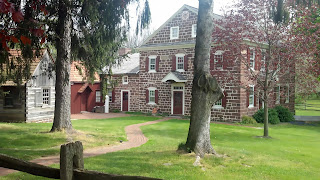The Kauffman's in America
Well, if you are still with me, let me first say that I have read and reread the letters, blogs, genealogical reports, probed ancestry.com and bunches of photostats to uncover what has happened next. Our earliest records from Uncle Walt (my father's uncle) speak of Rev. Isaac Kauffman as the first relative in America. The problem is that Isaac Kauffman was born in 1653. And he went to America in 1711 or so when he was relatively old. He then speaks of Christian Kauffman, the second son of Isaac Kauffman. But Christian was born in 1728. And born in Germany. He marries Barbara Baer. She was born in 1729. So, Christian is not likely the son of Isaac. I noticed some "hedging" in Uncle Walt's records. He writes in "Rev." refering to Isaac. Ralph Kauffman who Walt get's a letter said "probably". Someone else said likely the son or grandson. Isaac has a son Isaac. But his record said "nothing further was heard from him". It just was not right. And the "Genealogy of the Kauffman's" accurately reflects the more modern history of our family, it starts with reference of Isaac Kauffman ( -1738) who married Elizabeth ( -1751).
So, after hours of digging, and more dead ends I found a hint from another family tree that looked plausible. From my geneology, they said that it was an Isaac with a wife whose name was Elizabeth. No last name. No birth date but a death date. That lead to the answer. We are not related to ol' Rev. Isaac, is chased out of Switzerland, goes to Holland, avoids deportation to the East Indies and comes over about 1711 together with a large group of Mennonites America.
Rather we are related to his brother Jacob. Jacob has a large family and the records confuse some of the children. But he has a son Isaac born in 1693. Isaac marries Elizabeth Brubacker. Isaac comes to America with his uncle, Rev Isaac Kauffman.
In 1727, a law was passed by the Assembly of Province of Pennsylvania requiring all shipowners to make a list of all Swiss and Germans they bring to Pennsylvania. Previous to 1727, there is no present evidence of the names of the immigrants. Hence at this time we have no record of when the Kauffman's arrived. The ships left Holland, then sailed to England, probably docked at London's West India Company wharves, and after clearance was given, sailed to Cowes, on the Isle of Wright or Portsmouth, thereby. Then came a long two or more months voyage across the Atlantic. These ships were crowded with passengers whose quarters and food were filthy. Sickness and death too ofter cut the load of passengers to half the number who set out. They came up the Chesapeake and into the Susquehanna, going as far as Little Washington, where the rapids impeded further progress. There the passengers deem-barked.
For years the Rhine provinces of Germany permitted Swiss Mennonitcs its use as an asylum from the severe tribulations which had been their lot in Switzerland. While freedom of worship was permitted, the economic struggle was such that constant aid was supplied from the Mennonite congregations in Holland. Hardships multiplied with increasing numbers coming from Switzerland, especially in 1671 and 1711, when thousands were exiled. Friedelheim, Fricsheim, Brachweilerhof, Erpclzheim, Ober Sultzheim, Tribbaeh, Ibershcim, Manheim and other communities in the Palatiuate had quotas of Swiss Mennonite families. As early as 1683 a few venturesome Mennonites had gone to Pennsylvania where they founded Germantown. In 1690 Hans Milan is said to have erected the most pretentious house in Germantown. In 1696 Hans Graff and Henry Zimmerman came to Germantown. On june 24, 1710, Hans and Christian Herr, Martin Milan, Hans Funk, Jacob Miller, and Martin Kindig, Swiss Palatines, left London and arrived in Philadelphia in September. In October, 1710, they took up land in what is now Pequea Twp., Lancaster Co.. Pa. After houses had been erected and the crops set out in the spring of 1711, Martin Kindig returned to Europe with bright reports. However, it was not finally adopted by the Mennonite elders until Feb. 1717, at the conference at Manheim that mass settlement be made in Lancaster County. It was decided to solicit the Holland congregations for financial aid to assist in the project. Benedict Brechbill was able to collect 4000 guilders. June, 1717, the vessels set sail from Rotterdam, spending twelve weeks at sea coming by way of London to Philadelphia . Sept 1717, Captains Eyres, Tower, and Richards appeared before the Council of Pennsylvania with a total list of 363 Paletines brought over in their three vessels.
So where did they live?



Comments
Post a Comment